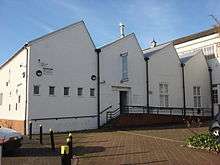Warner Textile Archive
The Warner Textile Archive is a UK-based collection of textiles, designs and paper records operated by Braintree District Museum Trust. It opened in 1993 and is the second largest collection of publicly-owned textiles in the UK (after the Victoria & Albert Museum).[1]

Based in Braintree, Essex the Archive consists of some 100,000 items representing the creative and commercial legacy of Warner & Sons, a leading textile manufacturer that operated from Braintree throughout much of the twentieth century.[1][2]
The Warner Textile Archive is housed in part of the original mill building at Silks Way, Braintree, and maintains a publicly accessible gallery along with rotating public exhibitions.[1]
Warner & Sons was a leading manufacturer of silk and velvet, as well as producing a wide range of other woven fabrics. Notably, it created the Queen's coronation robes and silk hangings used in Westminster Abbey during the coronation ceremony.[3] Representing two centuries of UK textile manufacturing history, the archive features work by artists/designers such as Augustus Pugin, William Morris, Vanessa Bell, Marianne Straub, Hans Tisdall, Lynton Lamb and Graham Sutherland.[1][2] The Warner archive was conserved for many years by the wallpaper and fabric company Walker Greenbank which sold the collection to Braintree in 2004.[4]
References
- "Warner Textile Archive, Braintree District Museum Essex". thegulbenkianprize.org.uk. Gulbenkian Prize. Retrieved 23 July 2014.
- "The Warner Archive by various, c1790-c1990". artfund.org. Artfund. Retrieved 23 July 2014.
- staff (8 April 2010). "The Warner Silk Mill in Braintree". Essex Life. Retrieved 22 July 2014.
- http://www.warnertextilearchive.co.uk/about-us/history/
External links
- Warner Textile Archive website
- BBC's A History of the World showing Queensway Coronation Silk designed by Robert Godden and woven by Warner & Sons
- British Pathé film showing Warner's staff weaving the Queen's coronation robes in 1952